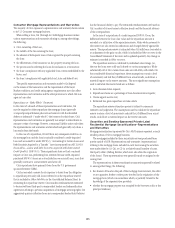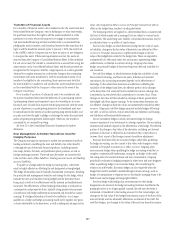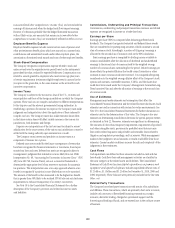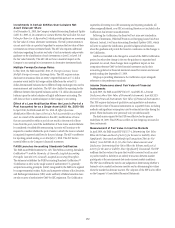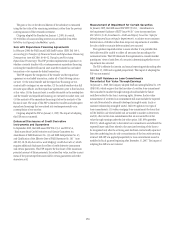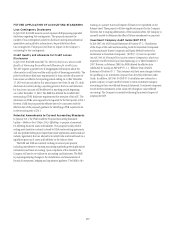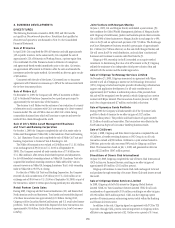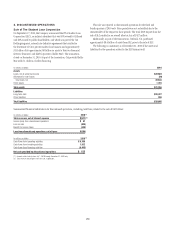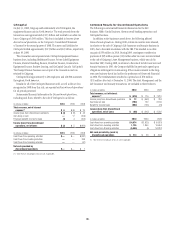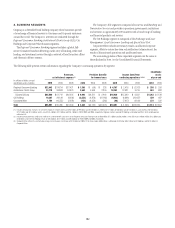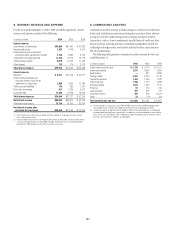Citibank 2010 Annual Report Download - page 176
Download and view the complete annual report
Please find page 176 of the 2010 Citibank annual report below. You can navigate through the pages in the report by either clicking on the pages listed below, or by using the keyword search tool below to find specific information within the annual report.174
The gain or loss on the deconsolidation of the subsidiary is measured
using the fair value of the remaining investment, rather than the previous
carrying amount of that retained investment.
Citigroup adopted the Standard on January 1, 2009. As a result,
$2.392 billion of noncontrolling interests was reclassified from Other
liabilities to Citigroup’s stockholders’ equity.
Sale with Repurchase Financing Agreements
In February 2008, the FASB issued FASB Staff Position (FSP) FAS 140-3,
Accounting for Transfers of Financial Assets and Repurchase Financing
Transactions (now ASC 860-10-40-42, Transfers and Servicing:
Repurchase Financing). This FSP provides implementation guidance on
whether a security transfer with a contemporaneous repurchase financing
involving the transferred financial asset must be evaluated as one linked
transaction or two separate de-linked transactions.
The FSP requires the recognition of the transfer and the repurchase
agreement as one linked transaction, unless all of the following criteria
are met: (1) the initial transfer and the repurchase financing are not
contractually contingent on one another; (2) the initial transferor has full
recourse upon default, and the repurchase agreement’s price is fixed and not
at fair value; (3) the financial asset is readily obtainable in the marketplace
and the transfer and repurchase financing are executed at market rates; and
(4) the maturity of the repurchase financing is before the maturity of the
financial asset. The scope of this FSP is limited to transfers and subsequent
repurchase financings that are entered into contemporaneously or in
contemplation of one another.
Citigroup adopted the FSP on January 1, 2009. The impact of adopting
this FSP was not material.
Enhanced Disclosures of Credit Derivative
Instruments and Guarantees
In September 2008, the FASB issued FSP FAS 133-1 and FIN 45-4,
“Disclosures About Credit Derivatives and Certain Guarantees: An
Amendment of FASB Statement No. 133 and FASB Interpretation No. 45,
and Clarification of the Effective Date of FASB Statement No. 161” (now
ASC 815-10-50-4K, Derivatives and Hedging: Credit Derivatives) which
requires additional disclosures for sellers of credit derivative instruments
and certain guarantees. This FSP requires the disclosure of the maximum
potential amount of future payments, the related fair value, and the current
status of the payment/performance risk for certain guarantees and credit
derivatives sold.
Measurement of Impairment for Certain Securities
In January 2009, the FASB issued FSP EITF 99-20-1, “Amendments to
the Impairment Guidance of EITF Issue 99-20” (now incorporated into
ASC 320-10-35-20, Investments—Debt and Equity Securities: Steps for
Identifying and Accounting for Impairment), to achieve more consistent
determination of whether other-than-temporary impairments of available-
for-sale or held-to-maturity debt securities have occurred.
Prior guidance required entities to assess whether it was probable that
the holder would be unable to collect all amounts due according to the
contractual terms. The FSP eliminates the requirement to consider market
participants’ views of cash flows of a security in determining whether or not
impairment has occurred.
The FSP is effective for interim and annual reporting periods ending after
December 15, 2008 and is applied prospectively. The impact of adopting this
FSP was not material.
SEC Staff Guidance on Loan Commitments
Recorded at Fair Value Through Earnings
On January 1, 2008, the Company adopted Staff Accounting Bulletin No. 109
(SAB 109), which requires that the fair value of a written loan commitment
that is marked to market through earnings should include the future
cash flows related to the loan’s servicing rights. However, the fair value
measurement of a written loan commitment still must exclude the expected
net cash flows related to internally developed intangible assets (such as
customer relationship intangible assets). SAB 109 applies to two types of
loan commitments: (1) written mortgage loan commitments for loans that
will be held-for-sale when funded and are marked to market as derivatives;
and (2) other written loan commitments that are accounted for at fair
value through earnings under the fair value option. SAB 109 supersedes
SAB 105, which applied only to derivative loan commitments and allowed the
expected future cash flows related to the associated servicing of the loan to
be recognized only after the servicing asset had been contractually separated
from the underlying loan by sale or securitization of the loan with servicing
retained. SAB 109 was applied prospectively to loan commitments issued or
modified in fiscal quarters beginning after December 15, 2007. The impact of
adopting this SAB was not material.



